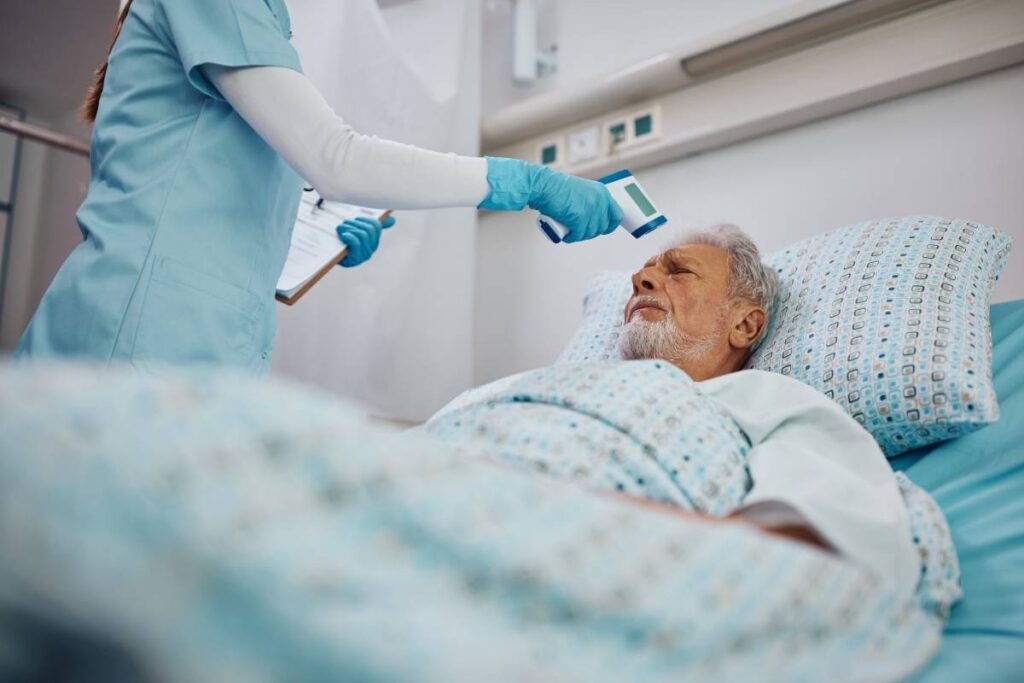Postoperative fever is the body’s reaction to infection and other stressors that may cause tissue damage and inflammation after surgery and is mediated by pyrogenic cytokines [5]. It is defined as a temperature greater than 38.3 degrees Celsius (101 degrees Fahrenheit) occurring within the first 72 hours after surgery [1]. Postoperative fever can be caused by various factors, including infection, tissue damage, and the body’s response to the stress of surgery [1]. In most individuals, fever is caused by benign conditions and resolves on its own. However, it is important for providers to be trained in the management of postoperative fever.
Fevers that develop within two days after surgery are more likely to be infectious.1 Postoperative fever is also possible following minor surgical operations, although it is infrequent [1]. A patient’s age and physical status are important factors in determining the significance of a fever in the postoperative phase [6]. Fever in newborns is more likely to be infectious. At the same time, malnourished and immunocompromised patients are more susceptible to developing nosocomial infections [6]. Surgical patients with DVT and PE often have a low-grade fever that subsides after a few days of therapy [1]. Patients who suffer anastomotic leakage or bowel obstruction have a poorer prognosis [1]. It is important to note that prior known drug hypersensitivity deserves special considerations [6].
The management of postoperative fever involves identifying and addressing the underlying cause and providing supportive care to the patient [1]. Treatment should be individualized to the patient and the underlying cause of the fever. Several strategies can be implemented to reduce the risk of postoperative fever, including proper sterilization of surgical instruments, prophylactic antibiotics before and during surgery, oxygen, and intravenous fluids [1,2,3]. Also, careful monitoring of the patient’s temperature and other vital signs during the postoperative period can help identify fever early [5]. If an infection is suspected, prompt treatment with antibiotics is essential to prevent the spread of the infection. Medication treatment involves a combination of medications, such as non-steroidal anti-inflammatory drugs (NSAIDs) and acetaminophen, to reduce fever and manage pain [4]. If not correctly diagnosed, patients can develop sepsis or septic shock resulting in extended hospitalization and death [1]. Adequate hydration and nutrition are also important, as the body’s immune system may be weakened following surgery, making the patient more susceptible to infection and other complications [7].
Fever is a common problem that arises in the postoperative period and increases burdens on doctors and the healthcare system while often also causing patients discomfort and distress [5,9].Healthcare providers need to carefully monitor patients for signs of infection and provide appropriate treatment to address the underlying cause of the fever [8]. Although most fevers in the initial postoperative period are not infectious, every fever warrants a thorough examination, including a comprehensive history and physical examination [5]. Asymptomatic individuals at low risk should be monitored and treated with antipyretics [5]. By implementing preventative measures and appropriate treatment strategies, healthcare providers can reduce the risk of complications and improve patient outcomes. Supportive care, including pain management, hydration, and nutrition, is also essential for managing postoperative fever and ensuring the best possible outcome for the patient [1].
References
- Abdelmaseeh TA, Azmat CE, Oliver TI. Postoperative Fever. [Updated 2022 Dec 3]. In: StatPearls [Internet]. Treasure Island (FL): StatPearls Publishing; 2022 Jan-. Available from: https://www.ncbi.nlm.nih.gov/books/NBK482299/?report=classic
- Andersen B. M. (2018). Prevention of Postoperative Wound Infections. Prevention and Control of Infections in Hospitals: Practice and Theory, 377–437. https://doi.org/10.1007/978-3-319-99921-0_33
- Crader MF, Varacallo M. Preoperative Antibiotic Prophylaxis. [Updated 2022 Sep 4]. In: StatPearls [Internet]. Treasure Island (FL): StatPearls Publishing; 2022 Jan-. Available from: https://www.ncbi.nlm.nih.gov/books/NBK442032/
- Ghlichloo I, Gerriets V. Nonsteroidal Anti-inflammatory Drugs (NSAIDs) [Updated 2022 May 19]. In: StatPearls [Internet]. Treasure Island (FL): StatPearls Publishing; 2022 Jan-. Available from: https://www.ncbi.nlm.nih.gov/books/NBK547742/
- Goyal-Honavar, A., Gupta, A., Manesh, A., Varghese, G. M., Jonathan, G. E., Prabhu, K., & Chacko, A. G. (2022). A prospective evaluation of postoperative fever in adult neurosurgery patients in the COVID-19 era. Journal of Clinical Neuroscience, 103, 26-33. https://doi.org/10.1016/j.jocn.2022.06.024
- Gupta, A. K., Singh, V. K., & Varma, A. (2012). Approach to postoperative fever in pediatric cardiac patients. Annals of pediatric cardiology, 5(1), 61–68. https://doi.org/10.4103/0974-2069.93714
- Hirsch, K. R., Wolfe, R. R., & Ferrando, A. A. (2021). Pre- and Post-Surgical Nutrition for Preservation of Muscle Mass, Strength, and Functionality Following Orthopedic Surgery. Nutrients, 13(5), 1675. https://doi.org/10.3390/nu13051675
- Monegro AF, Muppidi V, Regunath H. Hospital Acquired Infections. [Updated 2022 Aug 22]. In: StatPearls [Internet]. Treasure Island (FL): StatPearls Publishing; 2022 Jan-. Available from: https://www.ncbi.nlm.nih.gov/books/NBK441857/
- Sivakumar, B., Vijaysegaran, P., Ottley, M., Crawford, R., & Coulter, C. (2012). Blood cultures for evaluation of early postoperative fever after femoral neck fracture surgery. Journal of orthopaedic surgery (Hong Kong), 20(3), 336–340. https://doi.org/10.1177/230949901202000314

